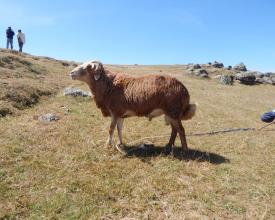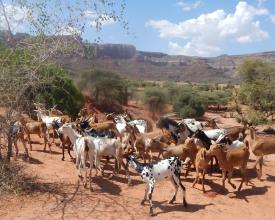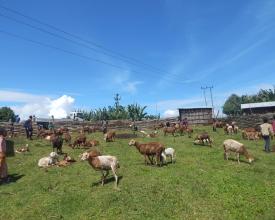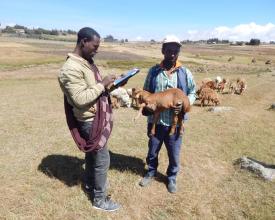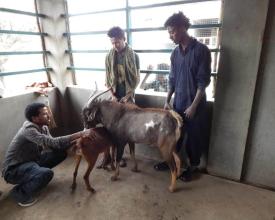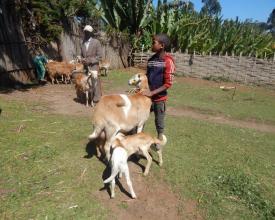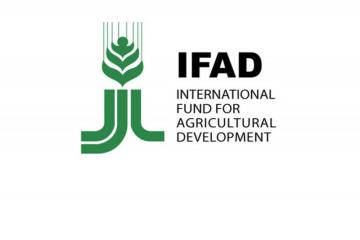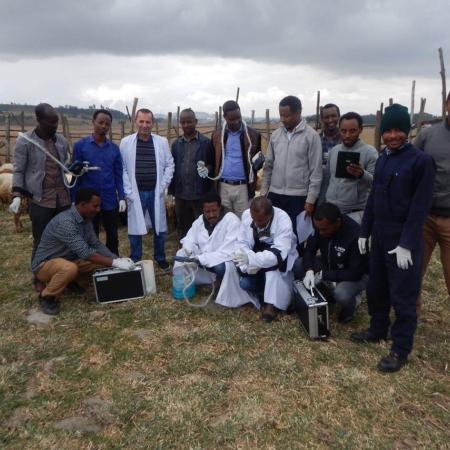
Plate-forme de reproduction à faible coût et à faible infrastructure pour soutenir les programmes d'élevage d'ovins et de caprins en Éthiopie

Grâce à la solution Reproductive Platform, les objectifs étaient d'établir des laboratoires de reproduction à faible coût et à faible infrastructure qui amélioreraient la fourniture de génétique améliorée pour les principales races ovines et caprines et contribueraient à la transformation de leurs programmes de reproduction en Éthiopie, réduiraient le risque que des béliers potentiellement inadaptés soient utilisés pour la reproduction et fourniraient aux communautés une nouvelle opportunité pour un modèle d'entreprise.Le réseau de laboratoires composant la plateforme de reproduction est entièrement géré par les instituts de recherche régionaux en Éthiopie et l'ICARDA a fourni la formation et la logistique nécessaires pour que les laboratoires soient entièrement opérationnels avec le soutien exclusif des institutions nationales.
Contexte
Défis à relever
L'utilisation de béliers et de boucs de qualité constitue l'épine dorsale des programmes de sélection. Des tentatives ont été faites pour améliorer la productivité des races indigènes par le biais de croisements avec des génotypes importés, mais peu d'efforts ont été déployés pour sélectionner des races indigènes de qualité en vue d'améliorer la productivité, y compris la reproduction. La qualité joue un rôle important dans la sécurité alimentaire et la nutrition et constitue un facteur essentiel pour éviter d'entraver la réussite des programmes de sélection bien établis ou émergents. Pour éviter les goulets d'étranglement, il est essentiel de comprendre les lacunes existantes en matière de connaissances pour les plans de transformation du bétail et la mise en œuvre des programmes de sélection. Ainsi, la demande croissante de produits issus des petits ruminants nécessite des objectifs efficaces, bien ciblés et clairs, et devrait être soutenue par une amélioration de l'alimentation, de la lutte contre les maladies et de la gestion de la reproduction pour les systèmes de production et de commercialisation. La qualité de la reproduction est à l'origine des moyens de subsistance sous forme de revenus, de nourriture et de matières premières industrielles.
Emplacement
Traiter
Résumé du processus
À l'origine, les programmes d'élevage communautaires (CBBP) en Éthiopie ont débuté à un niveau pilote impliquant un nombre limité de communautés et de villages pour chacune des races ovines et caprines ciblées. L'adoption de programmes d'élevage communautaires dans le plan directeur pour l'élevage et par d'autres initiatives largement financées dans le pays a créé une nouvelle demande en termes d'expansion/de mise à l'échelle des programmes d'élevage communautaires et, par conséquent, de nouvelles approches ont été nécessaires pour diffuser largement la génétique améliorée. Les partenaires éthiopiens ont demandé l'extension de la plate-forme de reproduction à un plus grand nombre de sites caprins, en particulier dans le nord du pays. Ces services comprennent des plans d'accouplement naturel programmés, l'insémination artificielle, des services de diagnostic de grossesse pour améliorer la gestion, la synchronisation de l'œstrus et la certification des géniteurs, ainsi que les activités de soutien de CapDev ciblant le personnel technique et les agriculteurs, membres des CBBP. Ces éléments représentent les principaux moteurs de la mise en place des plates-formes de reproduction et les deux éléments constitutifs simultanés (i) de l'établissement de l'infrastructure à proximité de chaque CBBP et (ii) de l'amélioration de la capacité technique du personnel régional en vue d'une autonomie maximale.
Blocs de construction
Réseau de laboratoires
Entièrement géré par les instituts de recherche régionaux d'Éthiopie et offrant une large gamme de techniques de reproduction et de biotechnologies, le réseau de laboratoires formant la plate-forme de reproduction fournit un soutien à la mise en œuvre des programmes d'élevage de moutons et de chèvres en Éthiopie simultanément à un certain nombre de services destinés à améliorer la gestion de la reproduction pour une plus grande productivité. Le co-investissement initial des instituts de recherche régionaux en Éthiopie et de l'ICARDA a permis à ce dernier d'améliorer le niveau de capacité du personnel régional et de fournir aux laboratoires l'équipement et les fournitures nécessaires pour fonctionner de manière autonome.
Facteurs favorables
- Investissement et implication des institutions nationales et de l'ICARDA
- L'extension des programmes d'élevage à de nouvelles communautés et à de nouveaux villages a généré une nouvelle demande en termes de technologies de reproduction pour une diffusion plus large de taureaux améliorés.
- Adoption par les acteurs nationaux de programmes d'élevage communautaires pour développer le secteur des petits ruminants.
Leçon apprise
- Approches contextualisées d'un point de vue technique et institutionnel pour établir les laboratoires de reproduction et les services fournis.
- Les technologies développées sont principalement basées sur des fournitures et des équipements disponibles localement pour que le modèle d'entreprise puisse être reproduit avec un minimum d'aide extérieure.
Activités de développement des capacités
Les plateformes de reproduction comprennent des plans d'accouplement naturel programmés, des inséminations artificielles, des services de diagnostic de grossesse pour améliorer la gestion, la synchronisation des œstrus et la certification des taureaux, ainsi que les activités de soutien de CapDev ciblant le personnel technique et les agriculteurs, membres des programmes d'élevage communautaires.
Facteurs favorables
- Participation des agriculteurs aux formations
- Financement continu par les institutions locales
- Identification des lacunes dans les connaissances
- Engagement continu des acteurs fédéraux et régionaux
Leçon apprise
Les connaissances acquises pour soutenir les plates-formes de reproduction dans le cadre des programmes d'élevage dans les systèmes à faible consommation d'intrants sont composées de modules qui peuvent être facilement reproduits grâce au développement des capacités et à la mise au point technique. Le développement des capacités des chercheurs et du personnel de vulgarisation éthiopiens doit se poursuivre jusqu'à l'expansion des programmes d'élevage communautaires et l'orientation du gouvernement vers l'adoption de cette approche pour l'amélioration génétique des races indigènes d'ovins et de caprins. L'identification des lacunes dans l'état actuel des connaissances encourage de nouveaux investissements dans la recherche et le potentiel de reproduction.
Impacts
- Adoption à grande échelle : Selon une étude basée sur la population ovine et caprine dans la zone du programme d'élevage communautaire, environ 540 000 ovins femelles adultes dans 9 Woreda et 370 000 caprins femelles adultes dans 3 Woreda en Éthiopie ont directement bénéficié ou sont exposés aux services, ce qui représente 6000 ménages au total bénéficiant de la plateforme de reproduction pour la fourniture de matériel génétique amélioré.
- Des rendements plus élevés: les écarts de rendement ont été comblés grâce à l'amélioration des pratiques de gestion de la reproduction.
- Gains génétiques: diffusion à grande échelle des gains génétiques dans le cadre des CBBP en Éthiopie.
- Méthodes améliorées: un protocole à base de prostaglandine composé de deux injections à 11 jours d'intervalle, précédé d'une sélection minutieuse des brebis non gestantes pour l'insémination artificielle cervicale à temps fixe avec du sperme frais, est une option de gestion de la reproduction réalisable pour soutenir les programmes d'élevage de moutons en Éthiopie ; les taureaux sélectionnés sont certifiés pour leur valeur génétique, leur aptitude à la reproduction et leur absence de maladies infectieuses.
- Amélioration de la fécondité: Des taux de conception allant jusqu'à 50-60% ont été atteints lors de vastes essais sur le terrain ; des améliorations de la fertilité globale et de la taille des portées dans les troupeaux des programmes d'élevage communautaires ont été enregistrées grâce à l'amélioration des pratiques de gestion accompagnant la mise en œuvre des programmes d'élevage.
Bénéficiaires
Les principaux bénéficiaires de cette solution sont les petits ruminants et les petits exploitants agricoles.
Objectifs de développement durable
Histoire

Parmi les fonctions assurées par la plate-forme de reproduction figure la prestation de services pour le diagnostic de grossesse. Le personnel qualifié des instituts régionaux de recherche agricole se rend régulièrement dans les communautés et les agriculteurs (hommes et femmes) ont la possibilité d'amener leurs brebis et leurs chèvres pour un contrôle rapide de leur état de grossesse. Cela permet aux agriculteurs de contrôler les reproducteurs, de repérer les femelles gestantes qui ne devraient pas être emmenées au marché. Il s'agit de l'unité mobile d'obstétrique et de gynécologie pour les ovins et les caprins.

